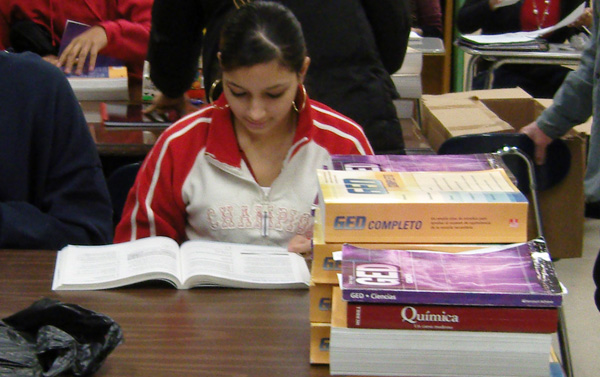
Photo by: Jarrett Murphy
A student in a GED class at the Mary Mitchell Center in the Crotona section of the Bronx in late 2007.
There are 1.3 million adults in New York City who are out of school and lack a high school credential—this figure doubles when we look statewide. For these individuals, the test of General Educational Development (GED) has represented an important stepping stone, allowing them to enroll in college and get jobs for which they would otherwise be unqualified.
These advances mean higher incomes for test-passers, and higher tax revenues and a more productive economy for the rest of us: a new release from the U.S. Census Bureau in February showed that GED holders earn, on average, significantly more than individuals without the credential who do not complete high school: $30,915 versus $24,520 per year, an increase of 26 percent.
For years, the exam had been developed and provided to states, for a fee, by the GED Testing Service, a unit within the American Council on Education, a national nonprofit organization. But this year, the GED Testing Service was acquired by Pearson PLC, a for-profit organization based in the United Kingdom. Pearson has announced changes to the exam, planned for 2014, that will roughly double its price and could limit its access. New York State, which currently fully funds the price of the exam, would, using its current budget, only be able to test roughly half of those who now take the test each year.
Improving and modernizing the exam’s content is a valuable goal. Yet we cannot afford to have fewer people attain their equivalency diploma. As a large corporate entity, Pearson has strong lobbying abilities and relationships with public education officials, whom it has sent on trips to England, Finland, Singapore and Brazil. Pearson has the power to influence public policy and budgeting in both the testing and preparation aspects of the GED. As such, we should be sure to turn our attention not only to the proposed changes in the content of the exam, but the shifts in how our governments support people looking to use the GED test—or an alternative pathway—as a second chance to succeed in education and careers. We cannot allow the state to decrease the number of GED test-takers or push the increased cost of the test onto its consumers, who tend to be low-income individuals struggling to get ahead.
We must take steps to ensure that New Yorkers do not become victims to a private corporation’s monopoly over a product that is largely a public good.
State and city officials should consider engaging in a sustained effort to get as many people as possible to pass the existing GED before 2014. Today, there are 159,000 people in the state who have taken the exam but not yet passed all sections. The sections they have passed already will be voided by 2014, so we have an opportunity to get them through the exam now.
Historically, many of these adults seek to pass the exam before it changes, creating a test-taker surge that strains the city’s already strapped GED system. A coordinated effort is needed to increase public awareness, reach potential GED candidates, maximize GED testing and position New York City ahead of the curve in responding to the new GED challenge.
We’ve all seen scary signs on the subway warning us to stay away from sugary sodas or an extra beer. How about some positive messages to get your GED? Such an effort must include funds to promote and offer GED programs in community-based organizations, schools, libraries and community colleges so we don’t send people to programs that are too full to serve them.
We should also explore alternatives to Pearson. There are other ways to achieve a high school equivalency diploma than the GED, and we cannot afford to put all of our eggs in the basket of a policy tool that is now controlled by private interests.
New York City’s high schools already have an exam-based exit requirement in the Regents exams. Could the five standard Regents exams be tailored into one test for high school equivalency? Are there other assessments used locally or nationally that might serve as good alternatives?
We should invest in examining these options. And if we do decide to encourage one of these alternatives, we should ensure that the organizations that prepare and test individuals for the GED receive support to build their capacity to offer these assessments.
Ensuring that all individuals have the opportunity to earn an equivalency diploma needs to be a priority for our current administrations and for those candidates who seek to run in future elections. New York City’s voters agree. In CSS’s latest annual survey, six out of ten New Yorkers said they were personally willing to pay more taxes to spend more on programs to give young adults who have left school a chance to earn a high school diploma or GED.
Our economy cannot support large numbers of uncredentialed individuals—we need their contributions if this recovery is to be real. Investing in the skills that will allow them to attend college and get good jobs is smart policy.








